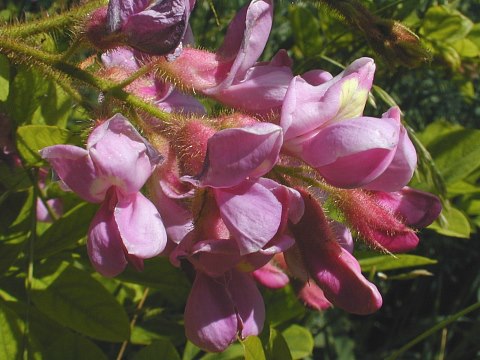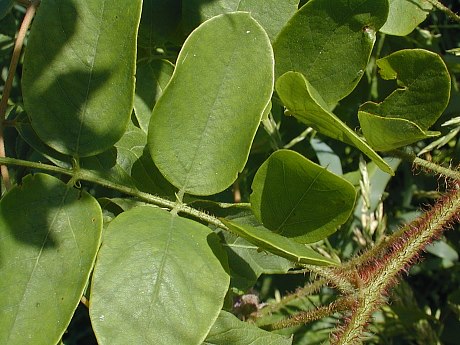Description: This shrub is 3-10' tall and across, branching abundantly. The bark of the trunk and larger branches is gray and fairly smooth. Young branches are green, terete, and very bristly-hairy. These long bristly hairs are purple-brown and sticky from minute glands. Alternate compound leaves occur at intervals along young branches; they are ¾–1½' long and odd-pinnate with 7-15 leaflets. The green rachis (central stalk) of each odd-pinnate leaf is slightly sticky-hairy. At the base of each rachis is a pair of sharp spines. Individual leaflets are 1-2" long and one-half as much across; they are broadly oblong, smooth along their margins, and hairless (or nearly so). Their upper surfaces are medium green, while their lower surfaces are pale green. Both axillary and terminal racemes of flowers are produced. Each raceme has 5-15 rosy-pink flowers; both the central peduncle of the raceme and its pedicels are covered with purple-brown bristly hairs. Each flower is about 1" long and nearly as wide; it has a short tubular calyx and 5 petals. The calyx is covered with purple-brown bristly hairs and it has 5 teeth. The petals are arranged like a typical pea-flower: there is large upright banner, a pair of lateral wings, and a partially hidden keel (the latter consisting of two petals). There is a patch of pale yellow at the base of the banner. The blooming period occurs from late spring to mid-summer and lasts about a month. Fertile flowers are replaced by elongated seedpods about 2-3" long. The seedpods are somewhat flattened and covered with purple-brown bristly hairs. Each seedpod eventually splits open into two parts to release its seeds. The root system is rhizomatous, often forming vegetative offsets.

Cultivation: This shrub adapts to full or partial sun, mesic to dry conditions, and various kinds of soil, including those that contain loam, clay-loam, or sand. It has a tendency to spread vegetatively and may be aggressive. Like other plants in this genus, it can increase the nitrogen levels of the soil.
Range & Habitat: Bristly Locust has escaped from cultivation and it has naturalized in different areas of Illinois (see Distribution Map). It is native to the hilly regions of southeastern United States, but will adapt to areas that are north of its original range. Habitats include thin upland woodlands, woodland edges, thickets, fence rows, roadside embankments, banks of drainage canals, vacant lots, and overgrown waste areas. Because of its attractive flowers and foliage, Bristly Locust is often cultivated as an ornamental shrub. Sometimes it is planted along embankments to control erosion.
Faunal Associations: Information for floral-faunal relationships is very little limited for this shrub. The flowers are probably cross-pollinated by bumblebees and other long-tongued bees; the Ruby-throated Hummingbird probably visits the flowers too. Insects that feed destructively on Bristly Locust (Robinia hispida) include the Locust Leafminer (Odontota dorsalis), another leaf-mining leaf beetle (Sumitrosis rosea), Putnam Scale (Diaspidiotus ancylis), and leaf-mining larvae of several moths, including the Black Locust Leafminer (Macrosaccus robiniella), Locust Digitate Leafminer (Parectopa robiniella), and Osten-Sacken's Locust Leafminer (Chrysaster ostensackenella); see Clark et al. (2004), Needham et al. (1928), and ScaleNet (accessed 2014).

Photographic Location: Along a drainage canal at Kaufmann Lake Park, Champaign, Illinois.
Comments: The most striking aspect of this shrub consists of the bristly purple-brown hairs that cover young stems, pedicels, calyces, and seedpods. These hairs probably discourage herbivory by some insects and deter nectar-robbing of the flowers by ants. Another species in this genus with a similar appearance is Robinia viscosa (Clammy Locust). While stems, calyces, seedpods, etc. of this shrub are covered by short sticky glands, they lack the long purple-brown hairs of Bristly Locust. Another species, Robinia pseudoacacia (Black Locust), is a tree that has spread northward into all areas of Illinois. This tree also lacks the long purple-brown hairs of Bristly Locust and its flowers are white, rather than rosy pink. In its native range in southeastern United States, Bristly Locust is a rather variable shrub and different varieties have been described. The typical variety (var. hispida) has been described here because it is more often encountered than other varieties of this shrub.